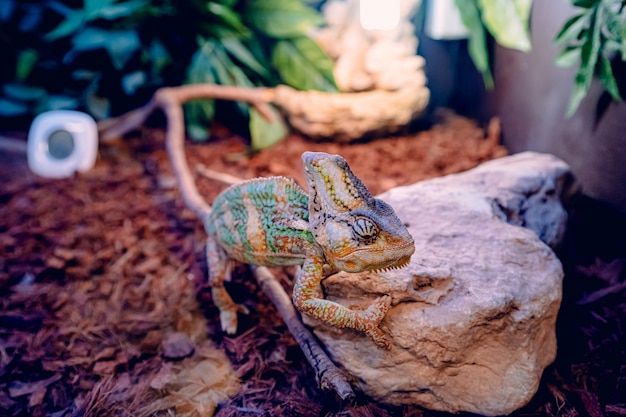

Reptiles are some of the oldest creatures on Earth.
Most reptiles lay eggs, but a few give live birth.
Snakes can swallow prey whole, thanks to their flexible jaws.
The skin of reptiles is covered in scales, providing protection and preventing water loss.
Tortoises can live for over a hundred years.
Some reptiles, like chameleons, change color to blend in with their surroundings.
Geckos have the ability to climb walls and ceilings due to their sticky toe pads.
Komodo dragons are the largest lizards in the world, growing up to 10 feet long.
Crocodiles have a bite force of over 3000 pounds per square inch.
Female reptiles, such as turtles and alligators, determine the temperature of their eggs, which determines the sex of the offspring.
Reptiles are ectothermic, meaning they rely on external sources of heat to regulate their body temperature.
Some reptiles, like the tuatara, have a third eye on top of their heads, which detects daylight and helps regulate their daily rhythms.
A group of crocodiles is called a bask.
Many species of snakes have a specialized heat-sensing organ that allows them to locate prey even in complete darkness.
Without reptiles, insect populations would explode, as they are natural predators of bugs.
Some reptiles, like the alligator snapping turtle, have a tongue that resembles a worm to lure prey into their mouths.
The spiny-tailed iguana can swim underwater for up to 30 minutes.
Reptiles have been portrayed as symbols of wisdom and cunning in various cultures throughout history.
The skin of some reptiles, like the boa constrictor, can change colors to help them blend in with their surroundings.
The Galapagos Islands are home to several unique species of reptiles, including the giant tortoise.
The temperature at which eggs are incubated can determine the gender of the hatchlings in some reptile species.
While reptiles generally have a bad reputation, most species are harmless to humans and play important roles in ecosystems.
The thorny devil lizard can drink water through its skin by absorbing it from puddles or dew.
Many reptiles have tails that can be shed and regrown as a defense mechanism.
The green sea turtle can migrate long distances, swimming thousands of miles between feeding and nesting grounds.
Some snakes, like the king cobra, can raise a third of their bodies off the ground when attacking.
Reptiles are cold-blooded, meaning their internal body temperature fluctuates with the environment.
The frilled-neck lizard can flare out the skin around its neck to make itself look bigger and scare away predators.
The Galapagos marine iguana is the only lizard in the world that can swim in the ocean.
The blood of some reptiles, like the American alligator, has natural antibiotic properties.
Some reptiles, like the gharial, have specialized snouts for catching fish.
The Madagascar day gecko has the ability to vocalize, producing chirping sounds similar to birds.
The inland taipan snake has the most potent venom of any land snake in the world.
The Komodo dragon has a venomous bite that can cause its prey to go into shock and eventually die.
Rattlesnakes use their rattles to warn potential threats, but the sound is also used as a means to communicate with other snakes.
Reptiles have a remarkable ability to regenerate certain body parts, such as claws and tails.
The Mary River turtle is known for its distinctive punk-like appearance, with algae growing on its head.
Some reptiles, like the frilled lizard, have a double-hinged jaw that allows them to open their mouths wider to catch prey.
Reptiles have adapted to various environments, from the frigid Arctic to the scorching deserts.
Skin-shedding is a common behavior among reptiles and helps them to remove parasites and improve their camouflage.
The chameleon’s eyes can move independently, allowing it to have a 360-degree view without moving its head.
Many reptiles, like the komodo dragon, have a forked tongue that helps them detect scents in the air.
Some snake species, like the cobra, have venom that can be deadly to humans, while others, like the rat snake, are harmless and actually help control rodent populations.
The limbs of snakes have evolved into specialized structures known as vestigial limbs, which are remnants of their ancient reptile ancestors.
The Gila monster, a venomous lizard native to the Southwestern United States, is one of the few known venomous lizards in the world.
Around the world, coffee enthusiasts enjoy Monin coffee concentrate since it is a multipurpose product. Conveniently combining…
The Importance of Choosing the Right Shower for Your Bathroom Renovating your bathroom can be…
Usain Bolt holds the record for the fastest 100-meter sprint in history.Bolt was named Sportsman…
Love is in the air... and it smells suspiciously like chocolate!Roses are red, violets are…
Life's a beach, take a picture and relax.Sun, sand, and salty kisses. That's what beach…
Hungary is home to the largest thermal water cave system in the world.The Rubik's Cube…